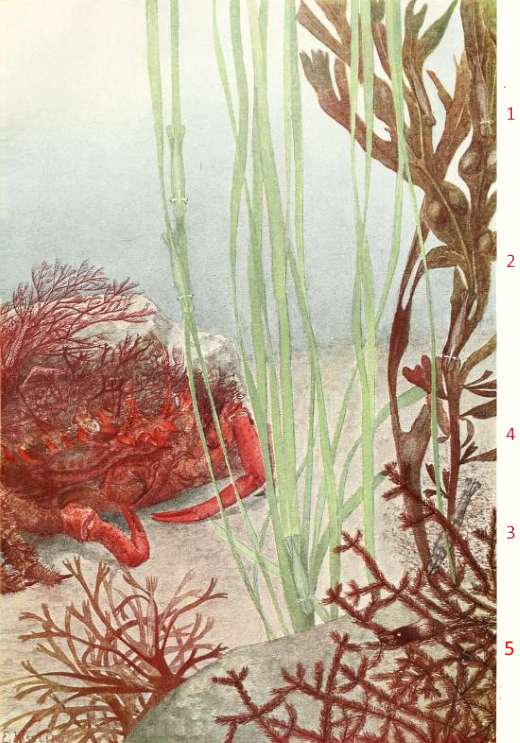forkweed
This is a common brown seaweed species along the
rocky shores. It has a worldwide distribution.
Forkweed cn be found on every continent, even around Antartica.
It can be found to a depth of 20 meters.

Forkweed is a brown seaweed, but is mostly green in color. It is about one decimeter in length.

Chameleon Prawn or Hippolyte varians and European spider crab or Maja squinado, source: "Tierbau und Tierleben in ihrem Zusammenhang betrachtet", 1930
8 Chameleon prawns can be distinguished: they can change of color, become transparant or with colored spots. At night the Chameleon prawn reflects a strange blue light.
1 eelgrass, shipswrack or Zostera marina
2 bladderwrack or Fucus vesiculosus
3 Hairy Sand Weed or Cladostephus spongiosus
4 spiny spider crab or Maja squinado
5 forkweed or Dictyota dichotoma
appearance
Dictyota dichotoma has ribbon-like fronds without a midrib and possess rounded edges.
On these fronds are black spots; these are the reproductive organs.
The fronds are very thin and translucent.
The thallus is brown in colouration and base is very short.

The fronds are very thin and translucent.
forkweed reproduction
There is alternation of generations and sexuality in Dictyota dichotoma:
The forkweed forms round spores that float around in the sea: These spores have no flagella.
They are called tetraspores as they are formed in groups of four.These spore grow out to an adult forkweed, resembling in appearance the parent from which it was developed, but this generation is bearing gametes.
The sex organs are called antheridia and oogonia. They are arranged in groups or black sori on the surface of the thallus on separate plants. So there are female and male forkweed plants producing eggs (oogonia) and sperms, that have flagella.
Both kinds of gametes are set free in large quantities at intervals of fourteen days, shortly after the highest spring tides.
The fertilised egg is called a zygote and will produce a forweed that only produces tetraspores.

Forkweed has alternation of generations and sexuality.
(source: botanische onderwijsplaten, UVA, Amsterdam)
vegetative reproduction
There is another way of reproduction :
The successful spread of the forkweed is due in part to its ability to asexually reproduce from ripped off fragments of this saeweed:
More importantly: if condition for the forkweed worsens , parts of the forkweed fall apart and drift away.
These parts have the ability to regenarate somewere else.

Seaweeds from the Northsea from P. Kuckuck.
1 Bladder Wrack or Fucus vesiculosus
2 Toothed Wrack or Serrated Wrack or Fucus serratus
3 Norwegian Kelp, Knotted Kelp, Knotted Wrack or Egg Wrack or Ascophyllum nodosum
4 Thongweed, Sea Thong or Sea Spaghetti or Himanthalia ellongata
5 Sea Oak or Halidrys siliquosa
6 forkweed or Dictyota dichotoma